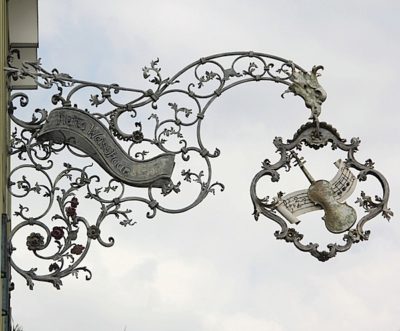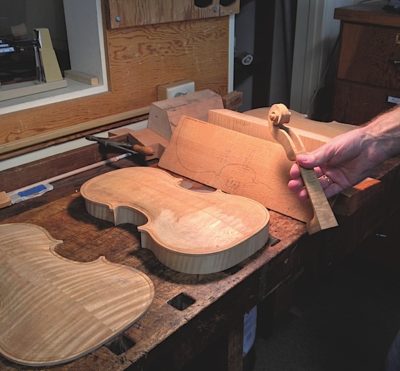Larchmont music shop enters its eighth decade

HANS WEISSHAAR sign is a neighborhood landmark.
For the last 70 years, anyone coming through our neighborhood has seen the landmark Hans Weisshaar sign at 627 N. Larchmont Blvd.
But does anyone really know what goes on in this decades-old violin shop?
As a former violinist, it was a satisfying experience walking into the shop. Georg and Ann Eittinger, the proprietors, greeted me in a room filled with the pleasant smells of wood and rosin, plus the mellow tones of string instruments. Polishes, cleaners, and instruments lined the walls, accompanied by photographs of past clients, demonstrating the rich history of Hans Weisshaar.
Included on my brief tour was a room for instruments to wait for repair or pickup, workshops on both first and second floors, a small business office, and then the kitchen, where Ann and Georg said the Larchmont Chronicle is regularly read.
How it works
These days, visits are made by appointment only. Besides bringing in instruments or bows for repair, clients might also be looking for a violin made by Georg Eittinger, seeking an appraisal on an instrument, looking for a violin to rent for themselves or their children, or asking for the name of a string teacher.
Eittinger said that there are parents who came to Hans Weisshaar as children who now bring their own children.

BACK AND FRONT of a violin in progress, using the flamed maple and spruce, respectively.
It can take anywhere from three days to three years to repair or restore a violin. There was one instrument that Eittinger reconstructed from 147 pieces. Building a violin from scratch also takes time. It begins with wood that has been aged at least 60 years; the best material comes from Germany and Bosnia. Flamed maple is used for the back and ribs (sides) of a violin, while spruce makes up the front. Ebony is used for the fingerboard.

THE SCROLL is also made of flamed maple.
According to Eittinger, it can take six to eight years to become a master violinmaker, or luthier. Eittinger spent three and a half years at the German State Violin Making School, which earned him a journeyman degree (Gesellenbrief in German). Apprenticing with a master is another way to earn a journeyman degree.
After working another three to five years with an accredited master, a journeyman can return to school for the master course and final test. The master degree also allows a violinmaker to take on apprentices.
How it began
Hans Weisshaar, the original founder of the violin shop, graduated from the state violin making school in Mittenwald, Germany and worked in Switzerland, the Netherlands and Germany. He immigrated to the U.S. in 1937, where he worked in Chicago and New York. He heard there was a need for a luthier and restorer in Los Angeles and landed on Larchmont Blvd. in 1947, where string instruments have been repaired, restored and crafted ever since.
Tradition
Over the decades, Hans Weisshaar became the destination for many professional string musicians, including Jack Benny, Jascha Heifetz and Isaac Stern.
Weisshaar even “wrote the book” on violin restoration when he co-authored “The Manual of Violin Restoration” with Margaret Shipman, who took over the shop in 1991 when Weisshaar died.

THIS VIOLIN by Georg Eittinger was built in 2016.
In 2004, Georg Eittinger, who had mentored at Hans Weisshaar in 1991 and 1992, bought the shop. In 2005 he opened a branch in Berlin, and more recently he opened a shop in San Marino.
Eittinger also teaches a bi-annual restoration course for professional violinmakers and lectures and writes articles on the art of violin making, restoration, and the violin trade.
Like many of its clients, music runs in the family. Georg plays the violin, cello and piano, while Ann is a flautist. Their twin sons, students at San Marino High and Los Angeles County High School for the Arts, play the violin and cello respectively.
For more information, or to make an appointment, call 323-466-6293 or visit hansweisshaar.com.
Category: People


